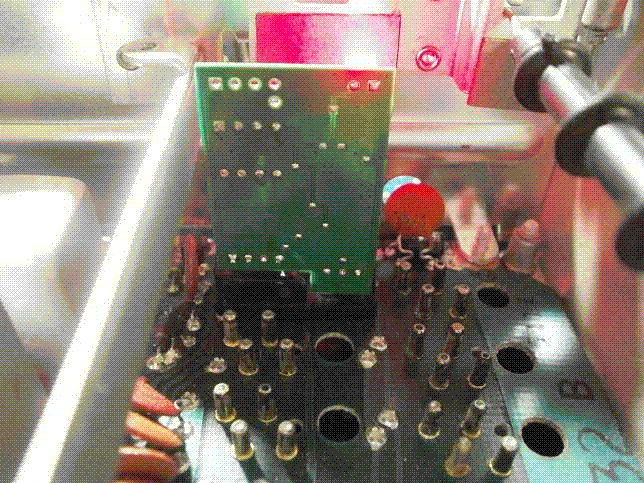
|
An Overview of the Molotora® Syncor® Full-Featured Radio By Matt Krick K3MK |

Recently discovered in a local semi-tralier converted storage shed belonging to Keith, KA6NLS was a stack of several cold war era surplus radios. On initial inspection these appeared to be your typical run-of-the-mill MICORs, but on closer inspection it was noted that these radios had additional cables that looked to be computer-related in nature.
After further review it was determined that these radio were a special limited edition run of radios based on the MICOR chassis.
These particular ones are UHF and were made for Arizona Department of Public Safety, similar to the VHF low band units special ordered by California Highway Patrol. In the stack were radios labeled X44RTA-4404AK-USB and X44RTA-4404AK-232.
General Specifications:
The Molotora Syncor is actually based on the MICOR chassis. Research indicates that it was designed as a gap-filling product for customers needing more channels than a Mitrek could offer, but were too cheap to upgrade their fleet of radios to ultra expensive Syntors and buy a R-1801 suit-case programmer. Also it eliminated the six month* lead time to change frequencies. (* typical time based on at least two orders lost in shipping from a crystal company in New Jersey).
The radio also had the added benefit of not requiring replacement of the mounting plate that was already drilled into the patrol car's gas tank or the control cable duct taped to the exhaust manifold as they were both forward compatible, making the Syncor the upgrade choice of lazy department radio shops across the country.
PL tone selection of all commercially used frequencies was accomplished by the use of the new 32 button PL1-PL32 head and a "super extender" which was another full sized radio chassis, but instead of another radio it contained a 12 VDC to 120 VAC dynamotor, Hitachi Magic Wand and servo mechanism to touch the massage head to one of the 64 tone reeds.
Transmitter and Receiver Capabilities:
Same as the MICOR. The PA finals are fragile as glass and will fail if you look at them wrong or ever use traditional 60/40 solder to repair it. The receiver is also fairly wooden, requiring a cascade of two Advanced Receiver Research (ARR) GaAsFET pre-amps just to get another 3dB of usable sensitivity.
Miscellaneous Options and Features:
"Wake-up Selcall":
Magnavolt, LLC. produced a selective call adapter based on their popular vehicle anti-theft system of the time. It gave dispatch the ability to wake an officer sleeping in his patrol car without needing another unit to tap on his or her window. The driver's seat was replaced with one that would give the officer a 10,000 volt jolt similar to what early stun guns could produce at the time.
The system required another "super extender" chassis to do the tone decoding. There were only 256 unique address combinations which was no problem for a small city, but when used on a state wide scale, the system would be triggered in three to four cars simultaneously.
"Dial a Cop Shop":
There was a prototype Systems 90 style head constructed to allow the driver "On the fly" frequency programming. It used three knobs similar to those found on the old clank-clank style UHF television tuners. These were special 100 position knobs labeled 00-99 and required using both hands to torque the knobs to the initial frequency. Since there was only one set of knobs the transmit frequency had to be set by hand before PTT could be pressed. The IF frequency offset had to be calculated by the operator (11.7 MHz for VHF high band and UHF, 5.26 MHz for VHF low).
Synthesizer lock required using one hand to spray the knobs with a can of DeoxIT D5 and the other to jiggle the knobs until the "Lock" NE-2 bulb lit on the channel element. Since there weren't enough pins on element plugs to bring out the logic signal, fiber optic cable was drilled through the lid of the radio and the other end duct taped to the side of the control head to facilitate this function. The first knob was usually always on "04", "14", "45", "46" or "47" it seldom needed to be jiggled.
This predated cellular phones with texting capabilities so at the time it was considered unsafe for the officer to steer with his or her knees while transporting a suspect and relying on the officer to be able to recall the correct frequencies was somewhat of a problem during trials, so this head was not put into production.
Programming Options:
X44RTA-4404AK-232:
This radio has a four inch pigtail with DE-9 male connector sticking out of the main plug housing. Interface to the computer requires an expensive special straight through DE-9 cable with female connectors on both ends available from Molotora only. The radio is programmed using any RS-232 compatible dumb terminal capable of 9600 baud communications with no special software required.
Use of a null modem cable results in the radio going in to a special "melt down" mode, which wipes the internal memory and shorts the A+ and A- lines of the audio amplifier making the patrol car's battery explode catching the engine bay on fire* (* Ford cars only), thus preventing civilians from obtaining the frequencies stored in the radio.
X44RTA-4404AK-USB:
Almost as if they were able to see in to the future and could predict the obsolescence of RS-232 on newer computers, the Molotora engineers were able to devise the protocol and connector specifications of the USB 1.1 standard. So this version of the radio has a female USB-B pigtail extending four inches from the main plug housing. Computer interface requires an expensive USB-A to USB-B (USB Printer) cable that is no longer than six feet in length; these are usually $30 and are available from several retail outlets.
The software required to program this version of the radio (H2N-3904A) can be obtained from most Russian radio websites, in exchange for uploading any other version of Molotora Lair software you may happen to have.
Photographs:

What makes the Syncor so special? The KXN-9001A, 500 parts per billion stability channel element. The glow is from the "Lock" NE-2 bulb (the camera couldn't see the right color, which is actually orange with a hint of red).
Credits and Acknowledgements:
The first full duplexed Syncor was made operational as the K7MCH (UHF) repeater on 448.500- MHz, PL 123.0 Hz in Golden Valley AZ on 02-08-2012.
Molotora, Syncor, Syntor, MICOR, Mitrek, PL, DPL, and a bunch of other terms might be trademarks of their respective companies. They have been used without permission.
Contact Information:
The author ignores all e-mail. He cannot be contacted at: his-callsign@yippie.com
This page publicized on Thursday 32-Mar-2010 2400 local time.
Article text and photographs © Copyright 2012 by Matt Krick K3MK.
Artistic layout and hand-coded HTML by Robert W. Meister WA1MIK.
This web page, the information presented in and on its pages and in these modifications and conversions is Copyright © 2012 by the author. All Rights are Reserved, including that of paper and web publication everywhere and anywhere. The web site owner has no right to distribute this anywhere else. Permission will not be given to have it hosted elsewhere. In fact, no one has permission to even read this article.